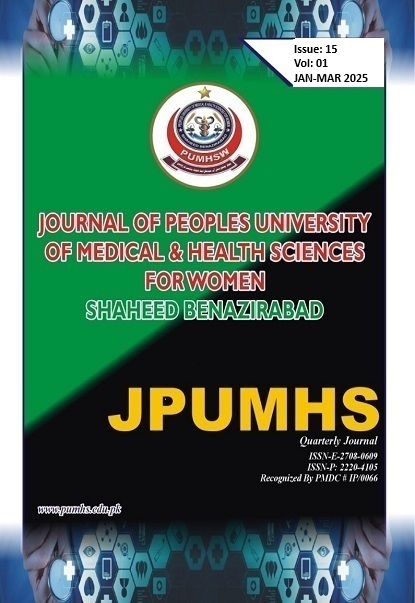DEEP VENOUS THROMBOSIS PROPHYLAXIS, STANDARDS AND PRACTICES.
JPUMHS; 2025:15:01,119-128. http://doi.org/10.46536/jpumhs/2025/15.01.605
Keywords:
Intermittent Pneumatic Compression, Prophylaxis, Thrombosis, Pressure stocking, venous thromboembolismAbstract
BACKGROUND: Deep venous thrombosis is life life-threatened critical vascular condition
in which the formation of blood clots occurs in deep veins, especially in lower limbs that may
lead to pulmonary embolism and post-thrombotic syndrome. Despite standardized guidelines
and protocols for the assessment of DVT risk and its prophylaxis, utilization remained
suboptimal, especially in developed or underdeveloped countries OBJECTIVE: The current
study aimed to evaluate current practices regarding DVT risk assessment by using the Caprini
Risk Assessment Model (RAM) in hospitalized patients. Moreover, it also aimed to investigate
the implementation of prophylaxis. METHODS AND MATERIAL: A prospective clinical
study was held in two phases across multiple wards of tertiary care hospitals (Prime Teaching
Hospital & Kuwait Teaching Hospital) in Peshawar. A total of 271 patients were recruited in
Phase I and 340 patients in Phase II. Healthcare professionals received education about the
dangers of DVT and the significance of prompt prophylaxis. Posters were also displayed in the
ward for underlining the necessity of VTE prophylaxis. Data was collected through a structured
checklist based on Caprini RAM protocols and SPSS v.22 was used for data analysis.
RESULTS/FINDINGS: The findings revealed that in both phases of the clinical study, the
majority of patients were observed to be at moderate risk followed by a high risk of DVT.
Preoperative risk assessment was conducted for 84.1% of patients in Phase I and 86,2% in
Phase II but a small percentage of patients received prophylaxis in the first phase (22.1%).
Then in the second phase of study, a significant improvement was observed up to 56.5%.
Regarding the type of prophylaxis, mechanical prophylaxis was a commonly used intervention
in both phases. CONCLUSION: Significant improvements observed in phase II highlighted
the potential of structured interventions and also enhanced awareness among health care
providers. Furthermore, it may benefit patients' quality of life and overall, well-being by
reducing the burden of complications associated with DVT.
Downloads
Downloads
Published
How to Cite
Issue
Section
License

This work is licensed under a Creative Commons Attribution-NoDerivatives 4.0 International License.




